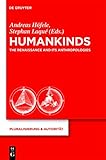Humankinds : The Renaissance and Its Anthropologies / ed. by Andreas Höfele, Stephan Laqué.
Material type: TextSeries: Pluralisierung & Autorität ; 25Publisher: Berlin ; Boston : De Gruyter, [2011]Copyright date: ©2011Description: 1 online resource (280 p.)Content type:
TextSeries: Pluralisierung & Autorität ; 25Publisher: Berlin ; Boston : De Gruyter, [2011]Copyright date: ©2011Description: 1 online resource (280 p.)Content type: - 9783110258301
- 9783110258318
- Anthropology
- English literature -- Early modern, 1500-1700 -- History and criticism -- Theory, etc
- Human beings
- Humanism in literature
- Humanism -- England -- History -- 16th century
- Humanism -- England -- History -- 17th century
- Renaissance -- England
- Renaissance
- Anthropologie/i.d. Literatur
- LITERARY CRITICISM / European / English, Irish, Scottish, Welsh
- Anthropology in Literature (Early Modern Age)
- GN25 .H86 2011eb
- online - DeGruyter
- Issued also in print.
| Item type | Current library | Call number | URL | Status | Notes | Barcode | |
|---|---|---|---|---|---|---|---|
 eBook
eBook
|
Biblioteca "Angelicum" Pont. Univ. S.Tommaso d'Aquino Nuvola online | online - DeGruyter (Browse shelf(Opens below)) | Online access | Not for loan (Accesso limitato) | Accesso per gli utenti autorizzati / Access for authorized users | (dgr)9783110258318 |
Frontmatter -- Contents -- Introduction -- Literary Sites of the Human -- Liminal Anthropology in Shakespeare’s Plays -- The Space of the Human and the Place of the Poet: Excursions into English Topographical Poetry -- Religious Beings -- Among the Fairies: Religion and the Anthropology of Ritual in Shakespeare -- Golding’s Metamorphoses, Shakespeare’s Twelfth Night and Puritan Anthropology -- Negotiating the Foreign -- When Golden times convents: Shakespeare’s Eastern Promise -- “Cony Caught by Walking Mort”: Indigenous Exoticism in the Literature of Roguery -- Renaissance Anthropologies of Security: Shipwreck, Barbary fear and the Meaning of ‘Insurance’ -- Human and Non-Human -- Shakespeare’s Public Animals -- “Fellow-brethren and compeers”: Montaigne’s Rapprochement Between Man and Animal -- Animal Art /Human Art: Imagined Borderlines in the Renaissance -- Thinking the Human -- “Now they’re substances and men”: The Masque of Lethe and the Recovery of Humankind -- Shakespeare Ever After: Posthumanism and Shakespeare -- Index
restricted access online access with authorization star
http://purl.org/coar/access_right/c_16ec
Anthropology is a notoriously polysemous term. Within a continental European academic context, it is usually employed in the sense of philosophical anthropology, and mainly concerned with exploring concepts of a universal human nature. By contrast, Anglo-American scholarship almost exclusively associates anthropology with the investigation of cultural and ethnic differences (cultural anthropology). How these two main traditions (and their ‘derivations’ such as literary anthropology, historical anthropology, ethnology, ethnography, intercultural studies) relate to each other is a matter of debate. Both, however, have their roots in the path-breaking changes that occurred within sixteenth and early seventeenth-century culture and scientific discourse. It was in fact during this period that the term anthropology first acquired the meanings on which its current usage is based. The Renaissance did not ‘invent’ the human. But the period that gave rise to ‘humanism’ witnessed an unprecedented diversification of the concept that was at its very core. The question of what defines the human became increasingly contested as new developments like the emergence of the natural sciences, religious pluralisation, as well as colonial expansion, were undermining old certainties. The proliferation of doctrines of the human in the early modern age bears out the assumption that anthropology is a discipline of crisis, seeking to establish sets of common values and discursive norms in situations when authority finds itself under pressure.
Issued also in print.
Mode of access: Internet via World Wide Web.
In English.
Description based on online resource; title from PDF title page (publisher's Web site, viewed 28. Feb 2023)


